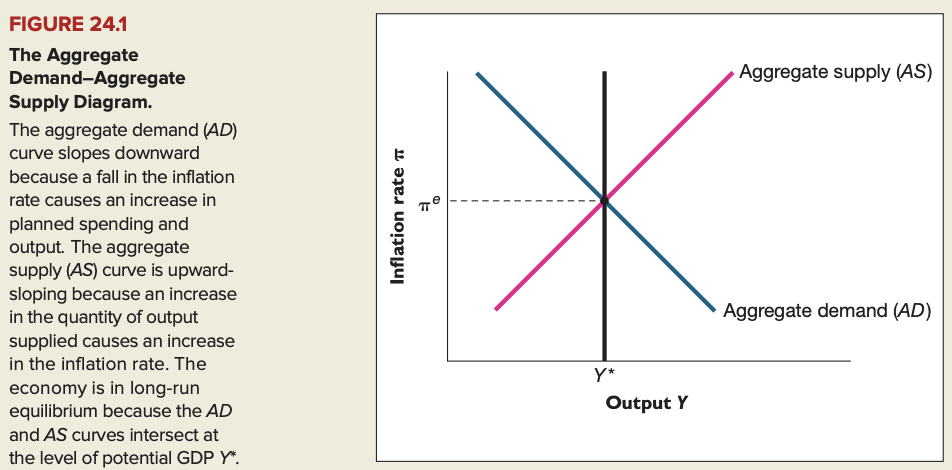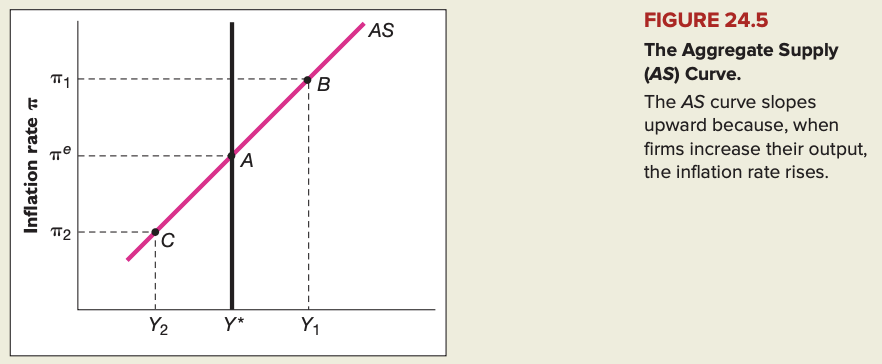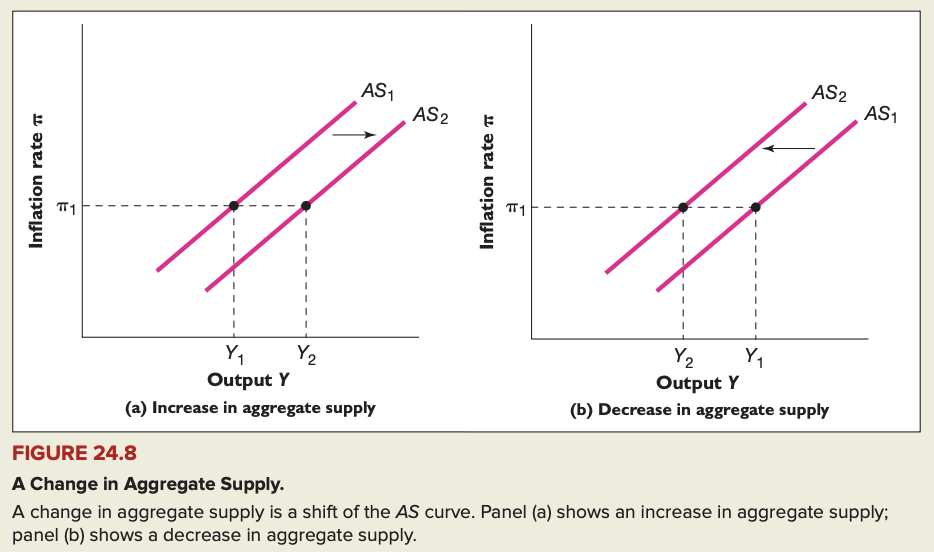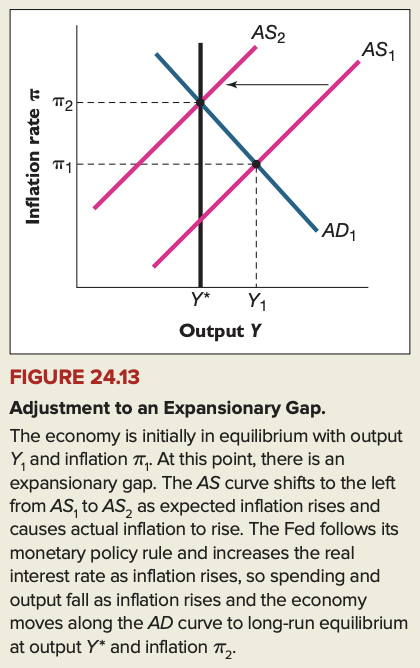
Chapter 24 - Aggregate demand, aggregate supply & business cycles
The aggregate demand-aggregate supply model: a brief overview

Long-run equilibrium: situation in which the AD and AS curves intersect at potential output Y*.
Short-run equilibrium: situation where the AD and AS curves intersect at a level of real GDP that is above or below potential.
Aggregate demand (AD) curve: curve that shows the amount of output consumers, firms, government, and customers abroad want to purchase at each inflation rate, holding all other factors constant.
Monetary policy rule: rule that describes how a central bank, like the Fed, takes action in response to changes in the state of the economy.
Change in aggregate demand: shift of the AD curve.

Demand shocks: changes in planned spending that are not caused by changes in output or the inflation rate.
The aggregate supply curve
Aggregate supply (AS) curve: curve that shows the relationship between the amount of output firms want to produce and the inflation rate, holding all other factors constant.

Change in aggregate supply: shift of the AS curve.

Inflation shock: sudden change in the normal behavior of inflation, unrelated to the nation's output gap.
Understanding business cycles
Business cycles are caused by shifts in aggregate demand and aggregate supply.
The primary causes of aggregate demand shifts are demand shocks, while the most frequent causes of aggregate supply shifts are inflation shocks.
The AD-AS model can be used to study business cycles by applying a five-step process:
Show the economy in long-run equilibrium
Identify how the AD and/or AS curves are affected
Shift the AD and/or AS curves in the appropriate fashion
Find the economy's new short-run equilibrium
Compare the new short-run equilibrium with the initial long-run equilibrium to show how output and the inflation rate were affected.
The Great Recession was the result of two negative demand shocks:
Declining house prices
2008 financial panic.
The self-correcting economy and stabilization policy
Inflation adjusts gradually to bring the economy into long-run equilibrium. Inflation rises to eliminate an expansionary gap and falls to eliminate a recessionary gap.
The more rapid the self-correction process, the less need for active stabilization policies to eliminate output gaps. In practice, policymakers' attempts to eliminate output gaps are more likely to be helpful when the output gap is large than when it is small.
Self-correcting property: fact that output gaps will not last indefinitely, but will be closed by rising or falling inflation.


Chapter 24 - Aggregate demand, aggregate supply & business cycles
The aggregate demand-aggregate supply model: a brief overview

Long-run equilibrium: situation in which the AD and AS curves intersect at potential output Y*.
Short-run equilibrium: situation where the AD and AS curves intersect at a level of real GDP that is above or below potential.
Aggregate demand (AD) curve: curve that shows the amount of output consumers, firms, government, and customers abroad want to purchase at each inflation rate, holding all other factors constant.
Monetary policy rule: rule that describes how a central bank, like the Fed, takes action in response to changes in the state of the economy.
Change in aggregate demand: shift of the AD curve.

Demand shocks: changes in planned spending that are not caused by changes in output or the inflation rate.
The aggregate supply curve
Aggregate supply (AS) curve: curve that shows the relationship between the amount of output firms want to produce and the inflation rate, holding all other factors constant.

Change in aggregate supply: shift of the AS curve.

Inflation shock: sudden change in the normal behavior of inflation, unrelated to the nation's output gap.
Understanding business cycles
Business cycles are caused by shifts in aggregate demand and aggregate supply.
The primary causes of aggregate demand shifts are demand shocks, while the most frequent causes of aggregate supply shifts are inflation shocks.
The AD-AS model can be used to study business cycles by applying a five-step process:
Show the economy in long-run equilibrium
Identify how the AD and/or AS curves are affected
Shift the AD and/or AS curves in the appropriate fashion
Find the economy's new short-run equilibrium
Compare the new short-run equilibrium with the initial long-run equilibrium to show how output and the inflation rate were affected.
The Great Recession was the result of two negative demand shocks:
Declining house prices
2008 financial panic.
The self-correcting economy and stabilization policy
Inflation adjusts gradually to bring the economy into long-run equilibrium. Inflation rises to eliminate an expansionary gap and falls to eliminate a recessionary gap.
The more rapid the self-correction process, the less need for active stabilization policies to eliminate output gaps. In practice, policymakers' attempts to eliminate output gaps are more likely to be helpful when the output gap is large than when it is small.
Self-correcting property: fact that output gaps will not last indefinitely, but will be closed by rising or falling inflation.


 Knowt
Knowt